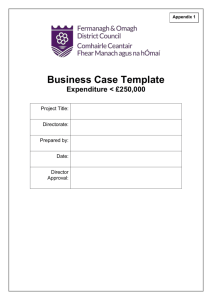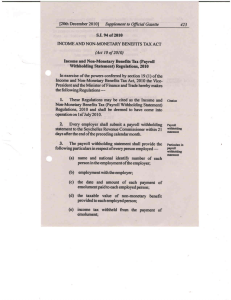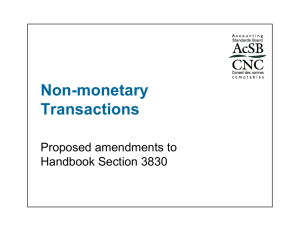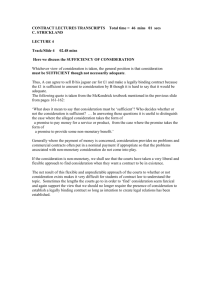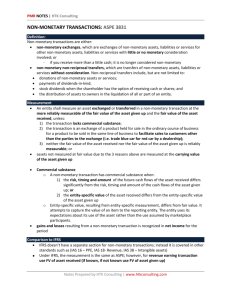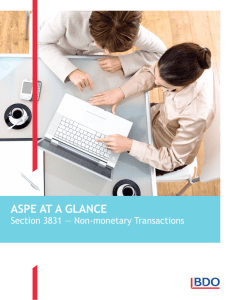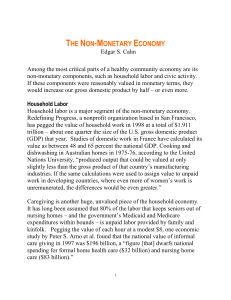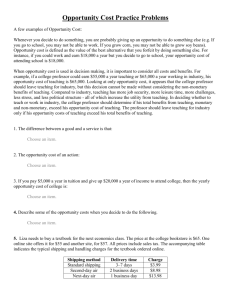Chapter 12 Exchange of non
advertisement
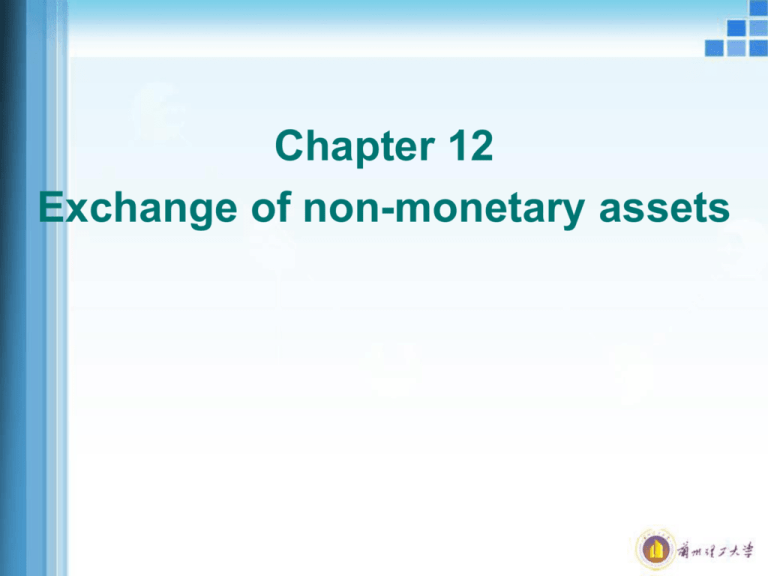
Chapter 12 Exchange of non-monetary assets exchange of non-monetary assets Non-monetary assets and monetary assets Monetary assets: currency held by financial companies and will be fixed or determinable amount of money charged assets, including cash, bank deposits, accounts receivable and notes receivable, and prepared to hold to maturity bond investments. Non-monetary assets: assets other than monetary assets Exchange non-monetary assets Non-monetary assets and monetary assets Monetary assets: currency held by financial companies and will be fixed or determinable amount of money charged assets, including cash, bank deposits, accounts receivable and notes receivable, and prepared to hold to maturity bond investments. Non-monetary assets: assets other than monetary assets Non-monetary assets do not involve the following: 1. Other than the owner or the owner's nonmonetary non-reciprocal transfer of contingent assets (business to business; reciprocal transfers) 2,.Mergers, debt restructuring, issuance of shares of non-monetary assets acquired Recognition and Measurement Non-monetary assets and exchange gains and losses to determine the cost of different monetary assets. Solve two problems: 1.for the recorded value of assets determined? 2.whether the profit and loss for the assets? Two kinds of valuation basis: 1.fair value 2.book value Non-monetary assets, recognition and measurement are two cases: Fair value measurement basis: non-monetary asset swap both of the following conditions shall be at fair value and the related tax to be paid for the cost of assets, fair value and book value of assets for the difference between profit or loss : (1) the exchange has commercial substance; (2) exchange of assets or the assets of the fair value can be reliably measured. Book value measurement basis: does not have commercial substance or the fair value of Or assets involved in the exchange can not be reliably measured the exchange of nonmonetary assets should be in accordance with the book value for the assets and be paid the relevant taxes and charges, as for the cost of assets, premium regardless of whether they are related, are not recognized gains and losses; the premium received or paid as the cost for the assets to determine the adjustment factor. exchange nonmonetary assets Asset exchange monetary transactions have comme rcial substa nce fair value can be reliably measured fair value can not be reliably measured not have commercial substance See "income" criterion measured at fair value Measured at book value Fair value can be reliably measured to determine The following circumstances, that the exchange of assets or exchange the assets at fair value can be reliably measured: Exchange of assets or the assets in an active market, the market price should be determined based on its fair value. Exchange of assets or the assets there is no active market, but the same or similar assets in active markets, should be the same or similar contigent assets market price to determine their fair value. Exchange of assets or the assets do not exist for the same or similar assets, comparable market transactions, valuation techniques should be used to determine its fair value. The changes in fair value estimate range is small, or changes in estimates of fair value range, a variety of estimates used to determine the probability of fair value can be reasonably certain, as the fair value can be reliably measured. Exchange of assets and fair value for the assets can be reliably measured are, should be in exchange for the assets at fair value as determined for the cost basis of assets, but there is conclusive evidence that the fair value for the assets, except more reliable. Commercial real judge Enterprises should follow the requirements of substance over form to determine whether non-monetary asset exchange has commercial substance. Non-monetary assets exchanged one of the following two conditions, as has commercial substance: Change into, for the assets in the future cash flow risk, time and amount of significantly different. Change in, the assets present value of expected future cash flows is different from the difference and change into, change compared to the fair value of the assets is significant. Note: The exchange of asset classes and the relationship between commercial real: a different asset class exchange has commercial substance. Related party relationships with commercial real relationship: the existence of related party relationships may not have commercial substance lead. Accountant occupation judgment: 1 non-monetary assets judgment? 2 exchange of non-monetary assets judgment? 3 fair value to determine whether the judgment? 4 commercial essence judgment? 5 occupation judgment affects the profit 6 occupation moral effect on profit The measurement of the fair value accounting To the fair value of the assets surrendered and premium determined swap in asset value The fair value of the assets surrendered and the difference between the book value of profit and loss. Characteristics: rational, not be subject to tax adjustment. Discuss the problem: 1.related taxes and exchanged inward-going assets? Or with the assets surrendered? Whether they are to be paid? Change asset related taxes and fees included in the asset transfer income; exchanged inward-going assets related taxes and fees included in the relevant asset value. 2.taxes: price, price. The tax levied on the fair value. Change to reflect the output, change to obtain an invoice can reflect the input. 3.for the assets to pay the relevant taxes accounted for asset losses. Related taxes 1.stock: value-added tax, for the inventory to reflect the output tax, input tax amount for restocking reflect. No VAT invoice does not reflect the amount of input tax. For the inventory of the output tax charged for the cost of assets, change into inventory VAT separately reflected. 2. intangible assets: sales tax 3.fixed assets: real estate sales tax or personal property tax 4.the investment assets: stamp duty 5.the price of taxes: profit and loss account for the assets, exchange of assets at cost. = = = = The determinationg of cost for the assets (1) pay filling price on one side Change asset value ( cost ) the fair value of the assets surrendered + pay filling price + the relevant taxes and fees paid the fair value of the assets received + the relevant taxes and fees paid (2) receives the boot party Change asset value ( cost ) the fair value of the assets surrendered - Premium + the relevant taxes and fees paid the fair value of the assets received + the relevant taxes and fees paid The fair value of the assets surrendered and the difference between the book value? ( 1) for the asset inventory; the investment real estate shall be as sales, processing, to its fair value and revenue recognition, at the same time carryover corresponding cost. Value added tax: the price excluding tax ( 2) changing asset into fixed assets, intangible assets, the assets surrendered fair value and the difference between the book value, included in operating income and business expenditure. ( 3) the assets surrendered for long-term equity investment, available-for-sale financial assets, the assets surrendered fair value and the difference between the book value, included in investment income. Further consideration: If the fair value of the assets surrendered can be reliably identified, should be how to determine the value of the assets received? If the change and the fair value of the assets received can be reliably identified, should be how to determine the value of the assets received? If there is conclusive evidence of the fair value of the assets received than the fair value of the assets surrendered more reliable, should be how to determine the cost of the assets received and the assets surrendered should confirm the profit and loss? The accounting book value 1, in principle: in exchange for the assets book value addition and subtraction to determine the premium for the recorded value of assets 2 reasons: to prevent inflated profits 3, for the assets to pay the relevant taxes included for the cost of assets. 4 Rating: simple; Unreasonable; Last resort; Not allowed; Tax adjustments needed! Does not confirm the loss for the assets to determine the cost for the assets (1) the party to pay the premium For the recorded value of assets (cost) = For + book value of the assets to pay the premium payment of related taxes (2) the party receiving the premium For the recorded value of assets (cost) = Book value for the assets - the premium payment of related taxes A number of assets involved in the exchange of non-monetary assets First determine the total recorded value, then at fair value or book value ratio, assessed to determine the specific asset value. (1) non-monetary exchange has commercial substance of assets, and swapped in and out of the fair value of assets can be reliably measured, it should be changed into in accordance with the fair value of the assets fair value of assets accounted for the proportion of the total, for the exchange of assets The total cost allocated to determine the cost of the exchange of assets. To determine the fair value of the total cost. (2) non-monetary exchange has commercial substance of assets only for the fair value of assets can be reliably measured, it should be changed into in accordance with the fair value of assets the fair value of assets accounted for the total proportion of the total cost for the assets to distribution. To determine the fair value of the total cost. (3) non-monetary exchange has commercial substance of assets only for the fair value of the assets can be reliably measured, it should be changed into in accordance with the original book value of assets accounted for the original book value of assets in proportion to the total allocation to determine the fair value the total cost. (4) non-monetary assets do not have commercial substance only exchange for the assets fair value can be reliably measured, it should be changed into in accordance with the original book value of assets accounted for the original book value of assets in proportion to the total allocation. Book value determined by the total cost Non-monetary assets exchanged information disclosure Change into, change out of asset classes Exchange method for determining the cost of assets Change into, out of the assets for fair value and book value for the assets Non-monetary asset exchange gains and losses recognized Guidelines thinking 1.fair value and tax 2.the profit and loss for the assets 3. the relevant tax 4. tax policy 5. tax adjustments 6. to prevent the adjustment of profits
